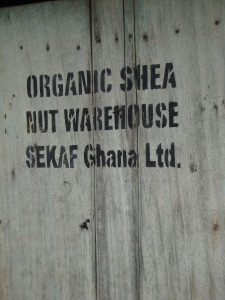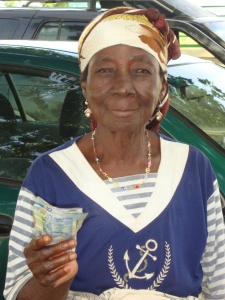This month I’ve been writing about the shea market and have introduced you to the shea nut collectors and the shea butter processors.
So what happens next?
Shea butter is traditionally used throughout Africa for “frying, adding to sauces, as a skin pomade [moisturiser], for medicinal applications, to make soap, for lanterns and for cultural purposes at ceremonies (births, weddings and funerals).” (Global Shea Alliance website)
Shea nuts and butter are also exported and around 90%-95% of shea used abroad is for food manufacturing, mostly for chocolate (it has the same melting point as cocoa butter), confectionary and margarine, much of it in the US market. However, the shea nuts are generally processed into refined shea butter in factories abroad rather than in Africa.
The use of shea butter in cosmetics and personal care items is growing and accounts for around 5-10% of shea exported from Africa. Shea butter is known to have therapeutic properties and it can heal and moisturise skin and reduce wrinkles due to its high level of antioxidants (especially in organic, unrefined shea butter). The local people have been using it for years and almost all West Africans will have used it at some point in their lives, particularly during the dry Harmattan period when people suffer from cracked lips and heels.
The Body Shop’s Anita Roddick discovered the amazing benefits of shea butter when she travelled to Ghana and the Body Shop has been trading with a community not far from Tamale for years now. L’Occitane also has a shea butter operation in Burkina Faso. Both companies are recognised for helping to develop the communities they work with and the Body Shop’s way of operating set the standards now used by the Fairtrade foundation.
However, this isn’t always the case. It’s great that shea butter is reaching such large audiences through cosmetics and food but the majority of the industry it is not actively helping the people at the bottom of the chain who are generally very poor.
The middle (wo)men traders benefit from buying the raw shea nuts cheaply in places like Ghana and then sell to customers abroad. The manufacturers buy the nuts from the traders and then add further value by processing it into shea butter using machines. They might manufacture the end product themselves or sell the butter to another manufacturing company.
So the middle (wo)men and manufacturers do business, make lots of profit and benefit from the market opportunities available outside Africa. However, this doesn’t really improve the lives of the shea collectors and processors. Do you remember Mma Fati and Mma Sana?


Thankfully, organisations like the Global Shea Alliance (GSA) recognise this. GSA’s initiatives include improvement of quality standards (to grow the international market for African shea butter), sustainability programmes to protect natural resources and improve collecting and storage, and training/support for rural shea collectors. I went to their conference in Abidjan in March this year (see previous post and photo below).
The company I’m working with is an executive member of GSA and is involved in all stages of the market. It is adding value to the shea nuts in Ghana so that people here can benefit.
SeKaf Ghana buys nuts and adds a premium so that the shea nut collectors get more money per bowl of nuts than they would at market. They also train the shea nut collectors to ensure that their nuts are the best quality and are not rejected.
The company provides space and resources for the local women to process shea butter on site and also trains them to ensure that the butter is premium quality. The women are paid per 25kg box of finished and packaged shea butter and ways of increasing production are being researched. The more the women produce, the more they get paid.
The company sells the raw, unrefined, organic shea butter (perfect for cosmetics) to buyers and manufacturers abroad but also makes shea butter cosmetics itself (the TAMA range that I’ve talked about many times!).
By processing shea butter and making natural cosmetics within Ghana, SeKaf is providing jobs, a guaranteed market for the women, fair prices and high quality standards for export. I’ve also assisted the company to set up savings and loans schemes with a couple of the women’s groups. As a result of all this, the people at the bottom of the chain benefit and the profit stays in Ghana.
So, as a shea butter consumer, it’s good to know whether the shea butter moisturiser or tasty chocolate you’re enjoying is helping people like Mma Fati and Mma Sana out of poverty or keeping them in it.
In the next post I’ll talk about the end customer, what they are actually getting out of the shea market and what sorts of questions they should be asking.













